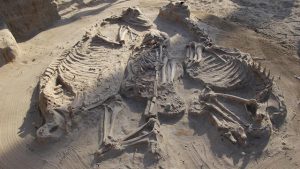Archaeologists learn about the past by piecing together artifacts from material culture: the tools, artwork and architecture left behind that tell us how ancient humans lived. But imagine being able to study their DNA, to learn about how different groups of people were related to each other, where they came from or even what kinds of diseases they had?
The concept of recovering DNA from ancient bones, especially those of humans and our evolutionary relatives, is still relatively new. Researchers can study the genome of modern-day populations of humans and extrapolate things about the past by comparing them to genomes of other groups. For example, if the genome of one group differs from a closely related group by a certain percentage, scientists could work backwards to calculate how long ago the two groups split, knowing the average amount of time it takes mutations, or random changes to genes, to accumulate.
But this approach requires making a lot of assumptions about the rate of genetic change and how these groups actually lived and interacted with each other. Asst. Prof. Maanasa Raghavan, a geneticist who recently joined the University of Chicago faculty to build an ancient DNA lab, wants to refine some of these assumptions and models by going straight to the source.
Read more HERE
Ask me anything
Explore related questions





